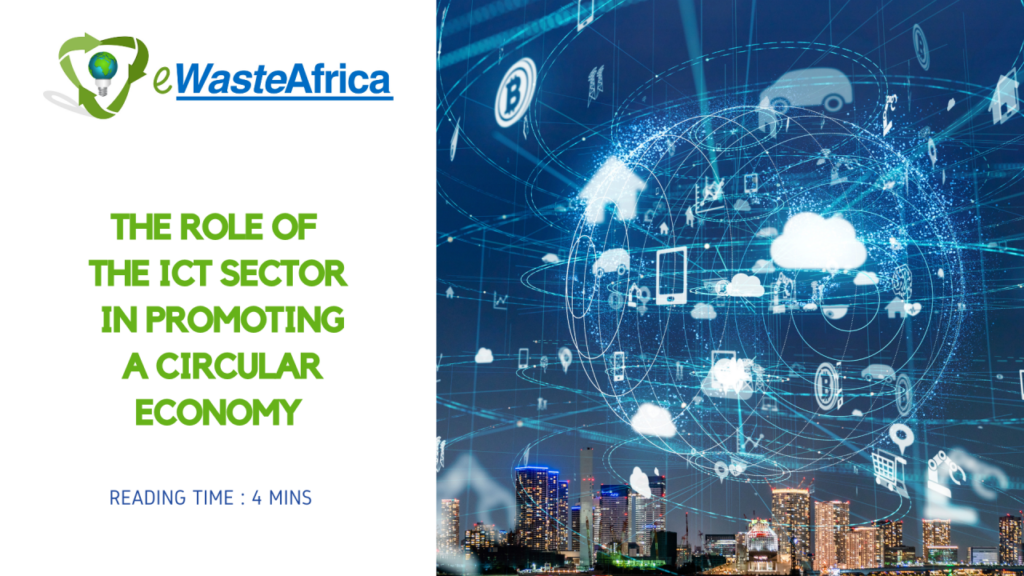
Reading time: 4 minutes
As the world faces the growing challenge of electronic waste (e-waste), the information and communications technology (ICT) sector has a unique opportunity to lead the way in reducing environmental impact and promoting sustainability. At EWaste Africa, we believe that by adopting circular economy principles, the ICT sector can make a significant difference in reducing waste, improving resource efficiency, and lowering carbon emissions.
So, what is a circular economy? Simply put, it’s a system designed to make the most of resources. In contrast to the traditional “take, make, dispose” approach, a circular economy in the electronic equipment market focuses on ensuring that equipment is used as much as and as efficiently as possible. This is through preferring repair, refurbishment and reuse, and then, as a last resort recycling. The goal is to keep products and materials in use for as long as possible, reducing the need for new resources and therefore protecting the environment.
How the ICT Sector Can Help
In the ICT sector, companies can help by adopting eco-design principles. Eco-design means designing products in a way that makes them easier to repair, reuse, and recycle. For example, devices can be designed with parts that are easier to fix or replace instead of being discarded when they break. This extends the life of products and reduces the need for new ones, cutting down on the resources needed to make new devices and the energy required in the manufacturing process.
By designing for repair and designing for reuse, companies in the ICT sector can help keep devices in use for longer, which reduces waste. Instead of throwing away a phone or computer when it’s damaged or outdated, people can repair or refurbish it (fix it up for resale), keeping it in circulation and reducing the need for new products. This also reduces the carbon footprint by decreasing the need for manufacturing new devices.
Moreover, products designed with easy-to-remove parts (such as screws instead of glue) are easier to take apart for recycling, allowing valuable materials to be recovered more easily. These materials—like metals and plastics—can be used to make new products, reducing the need for mining of new materials.
Challenges to Circularity in the ICT Sector
Despite these benefits, the ICT sector faces some challenges in adopting a circular economy approach. One of the biggest hurdles is consumer perception. Many people still think that refurbished (used or repaired) devices are lower quality and prefer to buy brand-new products. However, refurbished devices are often just as good as new ones and come at a lower price. For example, a refurbished device can be a more affordable option for people who want a premium brand but can’t afford the latest model.
Another challenge is that some consumers don’t fully understand the circular economy concept. For instance, many people are hesitant to rent a phone instead of buying one because they don’t understand how renting could benefit them in the long run. Additionally, as devices change hands from one person to another over time, it becomes harder to track the original source of the device and ensure they are properly disposed of when no longer working.
How We Can Overcome These Challenges
The key to overcoming these challenges lies in education. The more consumers know about the benefits of repairing, refurbishing, and recycling their devices, the more likely they are to embrace circular practices. By understanding that refurbished products can be high quality and that renting can be just as convenient as buying, people may be more open to adopting these sustainable options.
Partnerships between manufacturers, service providers, and recycling organisations are also crucial to making the circular economy work. While some manufacturers may be hesitant to support refurbishment because they see it as competition to new device sales, refurbished devices often appeal to a different market—those who can’t afford new products but still want the brand. Manufacturers can help by offering certification or training for recycling organisations, ensuring that refurbished devices meet the same standards as new ones.
Service providers can play a vital role in supporting these efforts by bringing certified refurbished products to market and helping to raise awareness about the benefits of these sustainable practices.
The Way Forward
In conclusion, adopting a circular economy in the ICT sector is not only possible but necessary. By designing products for repair and reuse, promoting refurbishment, and fostering collaboration between industry players, the ICT sector can make a real difference in reducing e-waste, conserving resources, and creating a more sustainable future.
At EWaste Africa, we are committed to supporting these efforts by offering recycling and refurbishment services ourselves or by encouraging other companies to join us in this important mission. Together, we can build a circular economy that benefits everyone—consumers, businesses, and the environment.

